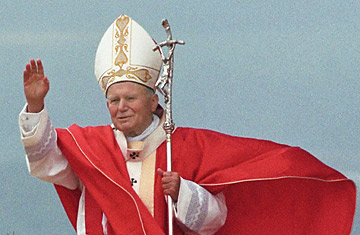
Pope John Paul II waves to a crowd in Gniezno, Poland, during a visit to his native country in 1997
A pardon from the Pontiff, a lesson in forgiveness for a troubled world
Usually it is the images of the immediate aftermath that are imprinted on the mind, the fragments of a normality shattered just a moment ago. The smoke from the bomb has scarcely cleared. Bodies on stretchers are jounced frantically toward the ambulances, and an arm waves at the camera to clear the way. Plaster clouds and torn clothes everywhere, the neighborhood blown out of its shoes. All in the same viewfinder: rescuers scramble in the chaos, a mother screams as if in Guernica, the stunned survivors move off with a slow, blank stare. The dead lie abruptly motionless wherever the latest outrage has deposited them.
Spectacles of terror and revenge occur so regularly that they seem to be scheduled into the routines of the world. They have become a way we punctuate our time. History unfolds as a sequence of detonations, a portion of the nightly news given over to psychosis. The scenes define a distinct style of politics in the world today, politics in a ski mask, violence dramatizing an unappeasable rage. Faceless, and morally depthless, the zealots crash truck bombs into their targets in Beirut or Tyre, go night riding with the Salvadoran death squads, or set the timers for the I.R.A. One sees their work—the almost daily deposits of bodies in the roads of Central America, for example. Or, in London, the innocent blown up to make an awful noise for Irish unity—horses of the Queen's Household Cavalry blasted while on parade, or Christmas shoppers at Harrods department store.
The memory keeps one picture in particular: St. Peter's Square in May 1981. It shows Pope John Paul II in white robes, capsized backward on his seat, stricken, in a posture vaguely reminiscent of the Pietà. There is an adrenal burst of motion in the scene as the security men spring alive and the Pontiff's white Popemobile lurches off through the crowd.
Ordinarily, the spasm of savagery simply passes and recedes in time, an ugly, vivid memory. But last week, in an extraordinary moment of grace, the violence in St. Peter's Square was transformed. In a bare, white-walled cell in Rome's Rebibbia prison, John Paul tenderly held the hand that had held the gun that was meant to kill him (see cover). For 21 minutes, the Pope sat with his would-be assassin, Mehmet Ah Agca. The two talked softly. Once or twice, Agca laughed. The Pope forgave him for the shooting. At the end of the meeting, Agca either kissed the Pope's ring or pressed the Pope's hand to his forehead in a Muslim gesture of respect.
It was a startling drama of forgiveness and reconciliation. On one level, it was an intensely intimate transaction between two men. But if the Pope spoke in whispers, he also meant to proclaim a message to the world. The only other people in the cell with Agca and John Paul were the Pope's personal secretary, two security agents—and a Vatican photographer and television crew. The Roman Catholic Church for many centuries has used imagery—paintings, sculpture, architecture—to express its spiritual meanings. The Pope brought the photographer and the cameramen because he wanted the image in that cell to be shown around a world filled with nuclear arsenals and unforgiving hatreds, with hostile superpowers and smaller, implacable fanaticisms.
